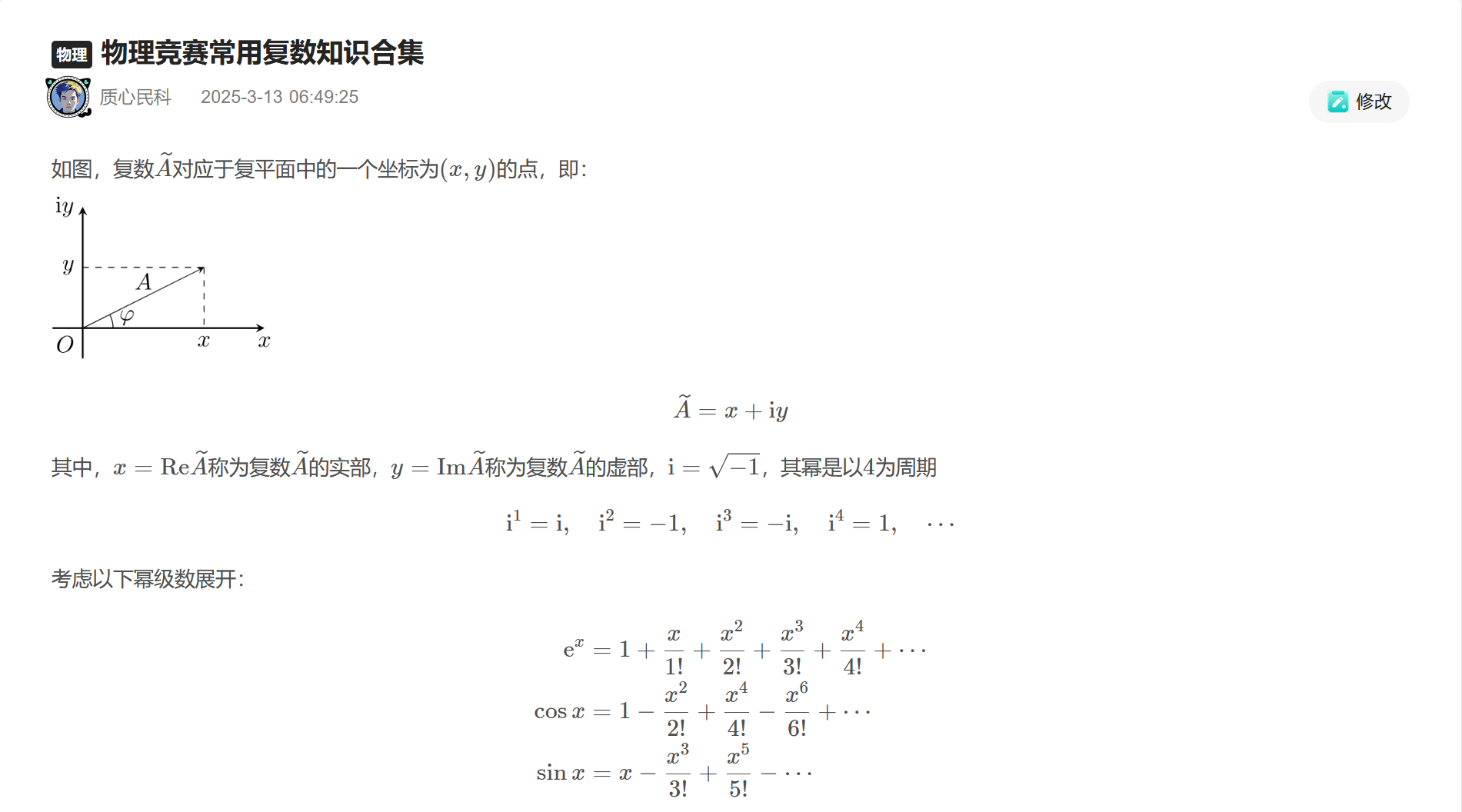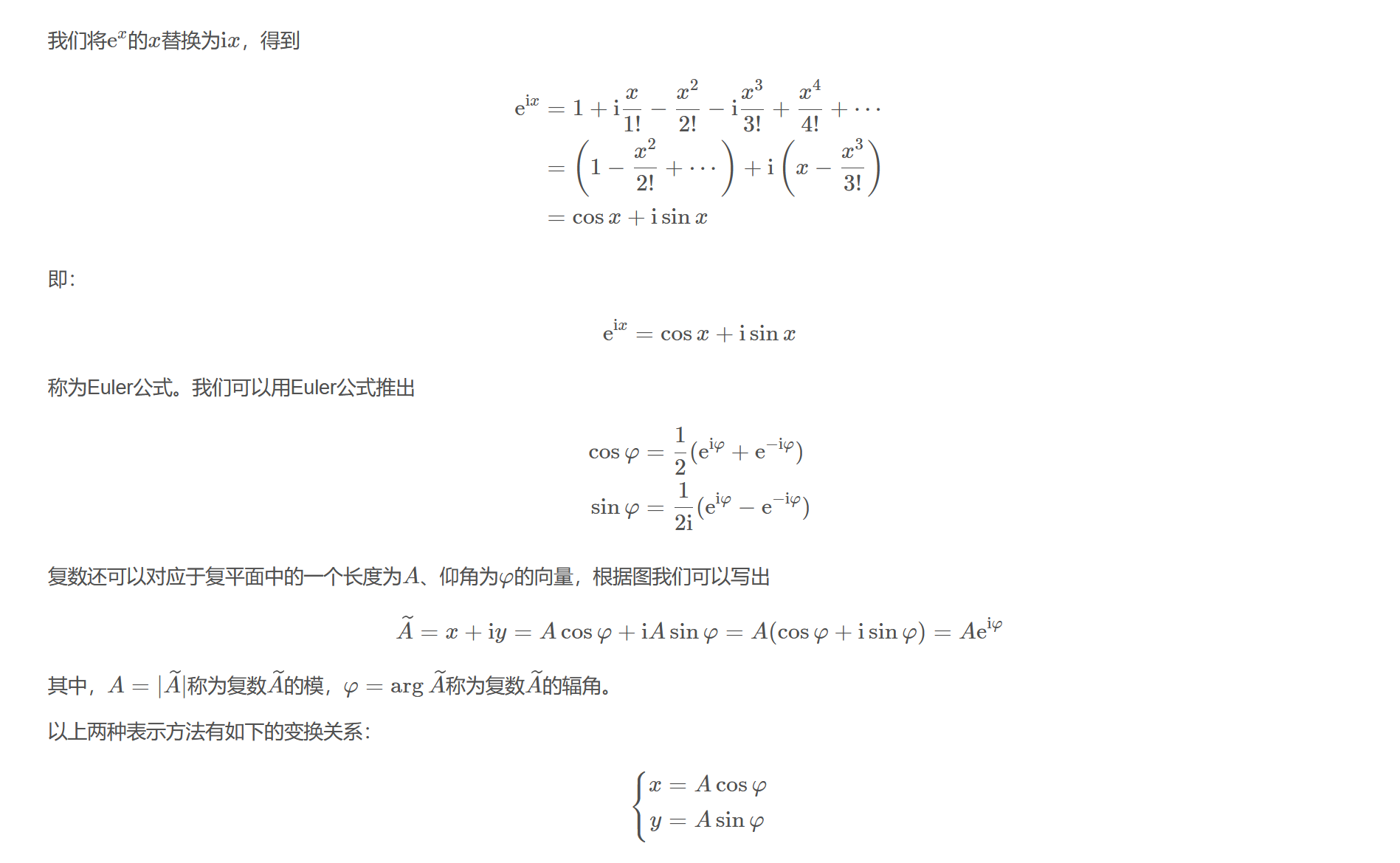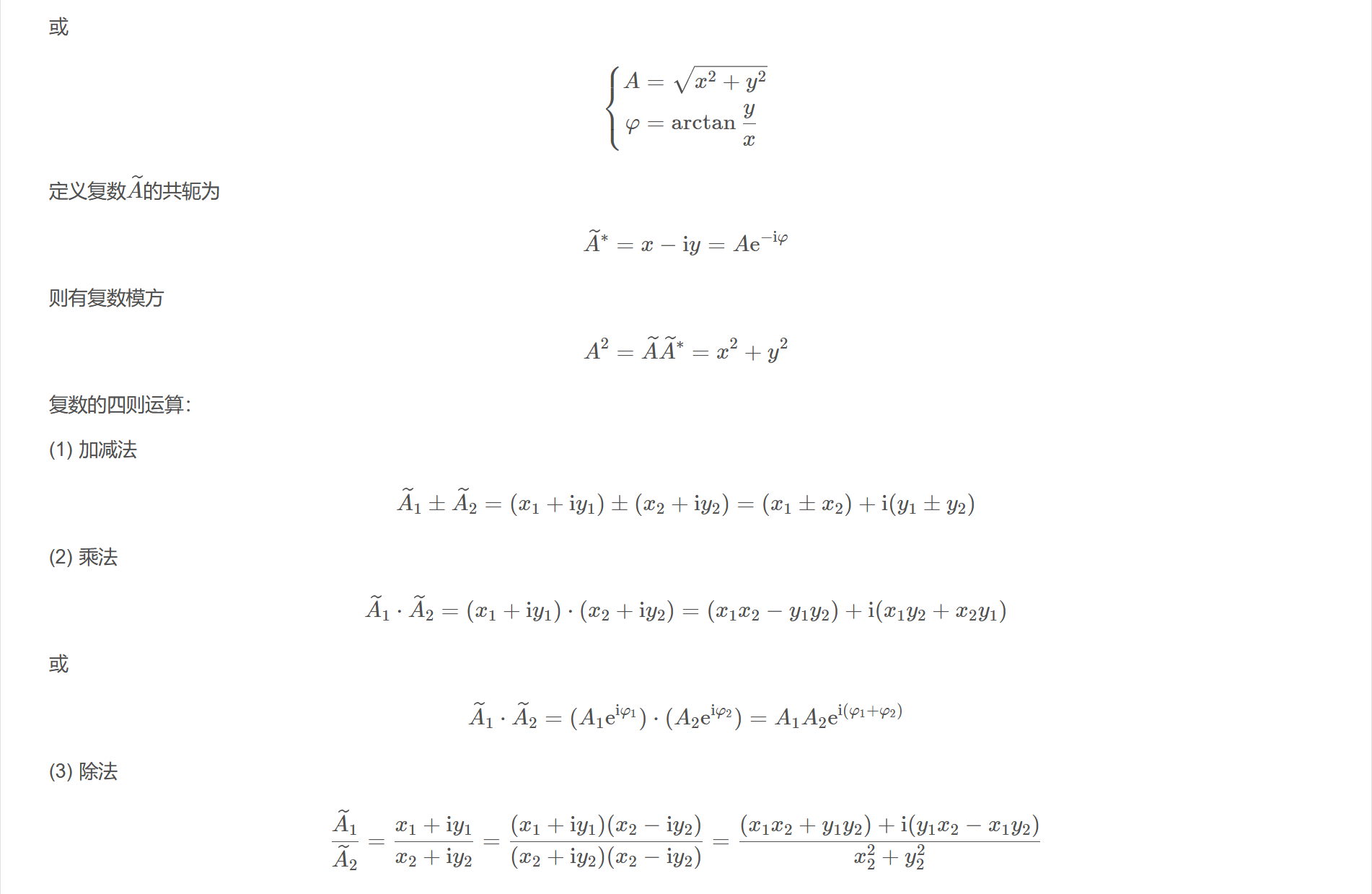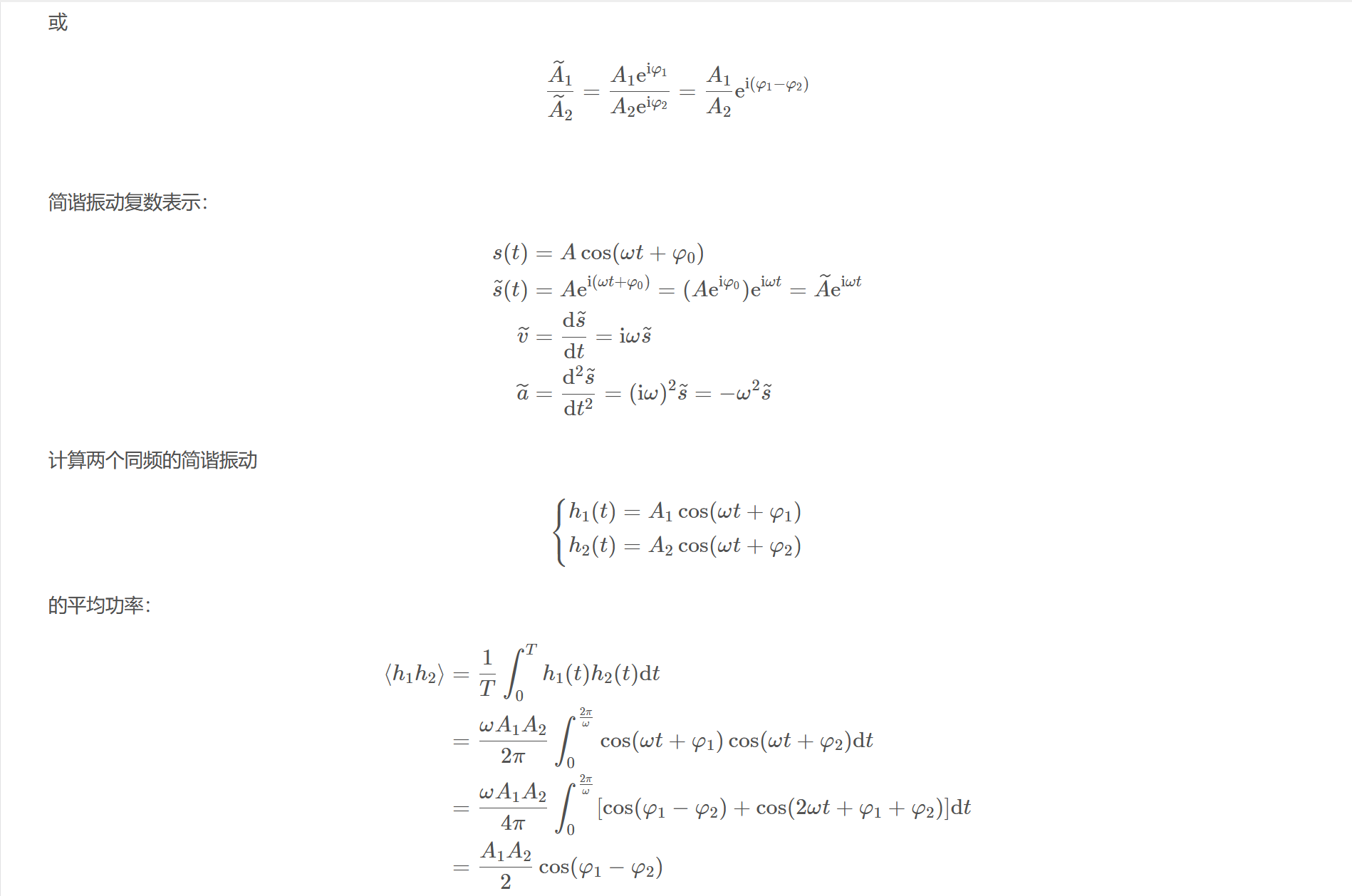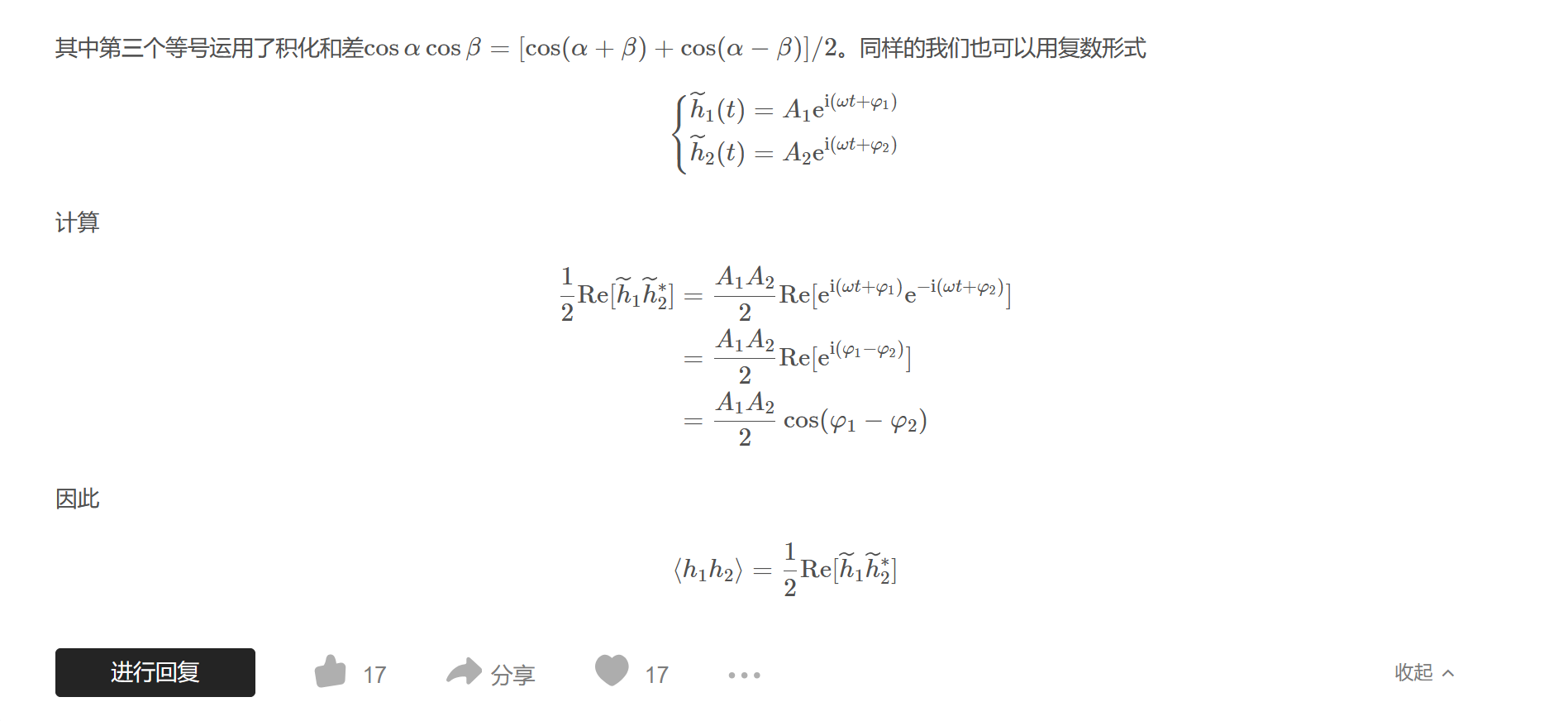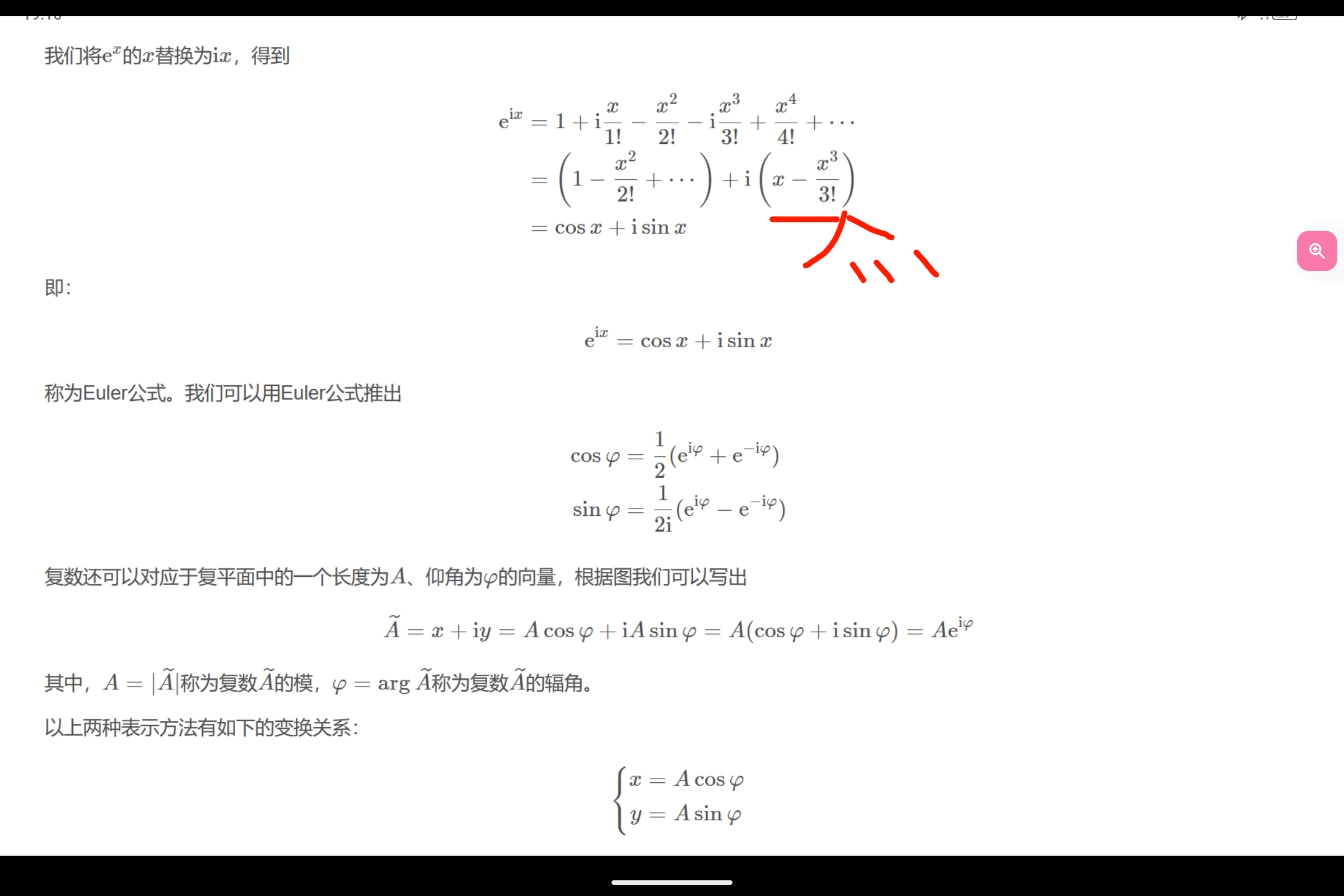物理 物理竞赛常用复数知识合集
如图,复数$\widetilde{A}$对应于复平面中的一个坐标为$(x,y)$的点,即:
$$\widetilde{A}=x+\mathrm{i}y$$
其中,$x=\mathrm{Re}\widetilde{A}$称为复数$\widetilde{A}$的实部,$y=\mathrm{Im}\widetilde{A}$称为复数$\widetilde{A}$的虚部,$\mathrm{i}=\sqrt{-1}$,其幂是以$4$为周期
$$\mathrm{i}^{1}=\mathrm{i},\quad \mathrm{i}^{2}=-1,\quad\mathrm{i}^{3}=-\mathrm{i},\quad \mathrm{i}^{4}=1,\quad \cdots$$
考虑以下幂级数展开:
$$\begin{aligned}\mathrm{e}^{x}&=1+\dfrac{x}{1!}+\dfrac{x^{2}}{2!}+\dfrac{x^{3}}{3!}+\dfrac{x^{4}}{4!}+\cdots\\\cos x&=1-\dfrac{x^{2}}{2!}+\dfrac{x^{4}}{4!}-\dfrac{x^{6}}{6!}+\cdots\\\sin x&=x-\dfrac{x^{3}}{3!}+\dfrac{x^{5}}{5!}-\cdots\end{aligned}$$
我们将$\mathrm{e}^{x}$的$x$替换为$\mathrm{i}x$,得到
$$\begin{aligned}\mathrm{e}^{\mathrm{i}x}&=1+\mathrm{i}\dfrac{x}{1!}-\dfrac{x^{2}}{2!}-\mathrm{i}\dfrac{x^{3}}{3!}+\dfrac{x^{4}}{4!}+\cdots\\&=\left(1-\dfrac{x^{2}}{2!}+\cdots\right)+\mathrm{i}\left(x-\dfrac{x^{3}}{3!}+\cdots\right)\\&=\cos x+\mathrm{i}\sin x\end{aligned}$$
即:
$$\mathrm{e}^{\mathrm{i}x}=\cos x+\mathrm{i}\sin x$$
称为Euler公式。我们可以用Euler公式推出
$$\begin{aligned}\cos\varphi&=\dfrac{1}{2}(\mathrm{e}^{\mathrm{i}\varphi}+\mathrm{e}^{-\mathrm{i}\varphi})\\\sin\varphi&=\dfrac{1}{2\mathrm{i}}(\mathrm{e}^{\mathrm{i}\varphi}-\mathrm{e}^{-\mathrm{i}\varphi})\end{aligned}$$
复数还可以对应于复平面中的一个长度为$A$、仰角为$\varphi$的向量,根据图我们可以写出
$$\widetilde{A}=x+\mathrm{i}y=A\cos\varphi+\mathrm{i}A\sin\varphi=A(\cos\varphi+\mathrm{i}\sin\varphi)=A\mathrm{e}^{\mathrm{i}\varphi}$$
其中,$A=|\widetilde{A}|$称为复数$\widetilde{A}$的模,$\varphi=\arg\widetilde{A}$称为复数$\widetilde{A}$的辐角。
以上两种表示方法有如下的变换关系:
$$\left\{\begin{aligned}x&=A\cos\varphi\\y&=A\sin\varphi\end{aligned}\right.$$
或
$$\left\{\begin{aligned}A&=\sqrt{x^{2}+y^{2}}\\\varphi&=\arctan\dfrac{y}{x}\end{aligned}\right.$$
定义复数$\widetilde{A}$的共轭为
$$\widetilde{A}^{*}=x-\mathrm{i}y=A\mathrm{e}^{-\mathrm{i}\varphi}$$
则有复数模方
$$A^{2}=\widetilde{A}\widetilde{A}^{*}=x^{2}+y^{2}$$
复数的四则运算:
(1) 加减法
$$\widetilde{A}_{1}\pm\widetilde{A}_{2}=(x_{1}+\mathrm{i}y_{1})\pm(x_{2}+\mathrm{i}y_{2})=(x_{1}\pm x_{2})+\mathrm{i}(y_{1}\pm y_{2})$$
(2) 乘法
$$\widetilde{A}_{1}\cdot\widetilde{A}_{2}=(x_{1}+\mathrm{i}y_{1})\cdot(x_{2}+\mathrm{i}y_{2})=(x_{1}x_{2}-y_{1}y_{2})+\mathrm{i}(x_{1}y_{2}+x_{2}y_{1})$$
或
$$\widetilde{A}_{1}\cdot\widetilde{A}_{2}=(A_{1}\mathrm{e}^{\mathrm{i}\varphi_{1}})\cdot(A_{2}\mathrm{e}^{\mathrm{i}\varphi_{2}})=A_{1}A_{2}\mathrm{e}^{\mathrm{i}(\varphi_{1}+\varphi_{2})}$$
(3) 除法
$$\dfrac{\widetilde{A}_{1}}{\widetilde{A}_{2}}=\dfrac{x_{1}+\mathrm{i}y_{1}}{x_{2}+\mathrm{i}y_{2}}=\dfrac{(x_{1}+\mathrm{i}y_{1})(x_{2}-\mathrm{i}y_{2})}{(x_{2}+\mathrm{i}y_{2})(x_{2}-\mathrm{i}y_{2})}=\dfrac{(x_{1}x_{2}+y_{1}y_{2})+\mathrm{i}(y_{1}x_{2}-x_{1}y_{2})}{x_{2}^{2}+y_{2}^{2}}$$
或
$$\dfrac{\widetilde{A}_{1}}{\widetilde{A}_{2}}=\dfrac{A_{1}\mathrm{e}^{\mathrm{i}\varphi_{1}}}{A_{2}\mathrm{e}^{\mathrm{i}\varphi_{2}}}=\dfrac{A_{1}}{A_{2}}\mathrm{e}^{\mathrm{i}(\varphi_{1}-\varphi_{2})}$$
简谐振动复数表示:
$$\begin{aligned}s(t)&=A\cos(\omega t+\varphi_{0})\\\widetilde{s}(t)&=A\mathrm{e}^{\mathrm{i}(\omega t+\varphi_{0})}=(A\mathrm{e}^{\mathrm{i}\varphi_{0}})\mathrm{e}^{\mathrm{i}\omega t}=\widetilde{A}\mathrm{e}^{\mathrm{i}\omega t}\\\widetilde{v}&=\dfrac{\mathrm{d}\widetilde{s}}{\mathrm{d}t}=\mathrm{i}\omega\widetilde{s}\\\widetilde{a}&=\dfrac{\mathrm{d}^{2}\widetilde{s}}{\mathrm{d}t^{2}}=(\mathrm{i}\omega)^{2}\widetilde{s}=-\omega^{2}\widetilde{s}\end{aligned}$$
计算两个同频的简谐振动
$$\left\{\begin{aligned}h_{1}(t)&=A_{1}\cos(\omega t+\varphi_{1})\\h_{2}(t)&=A_{2}\cos(\omega t+\varphi_{2})\end{aligned}\right.$$
的平均功率:
$$\begin{aligned}\langle h_{1}h_{2}\rangle&=\dfrac{1}{T}\int_{0}^{T}h_{1}(t)h_{2}(t)\mathrm{d}t\\&=\dfrac{\omega A_{1}A_{2}}{2\pi}\int_{0}^{\frac{2\pi}{\omega}}\cos(\omega t+\varphi_{1})\cos(\omega t+\varphi_{2})\mathrm{d}t\\&=\dfrac{\omega A_{1}A_{2}}{4\pi}\int_{0}^{\frac{2\pi}{\omega}}[\cos(\varphi_{1}-\varphi_{2})+\cos(2\omega t+\varphi_{1}+\varphi_{2})]\mathrm{d}t\\&=\dfrac{A_{1}A_{2}}{2}\cos(\varphi_{1}-\varphi_{2})\end{aligned}$$
其中第三个等号运用了积化和差$\cos\alpha \cos\beta=[\cos(\alpha+\beta)+\cos(\alpha-\beta)]/2$。同样的我们也可以用复数形式
$$\left\{\begin{aligned}\widetilde{h}_{1}(t)&=A_{1}\mathrm{e}^{\mathrm{i}(\omega t+\varphi_{1})}\\\widetilde{h}_{2}(t)&=A_{2}\mathrm{e}^{\mathrm{i}(\omega t+\varphi_{2})}\end{aligned}\right.$$
计算
$$\begin{aligned}\dfrac{1}{2}\mathrm{Re}[\widetilde{h}_{1}\widetilde{h}_{2}^{*}]&=\dfrac{A_{1}A_{2}}{2}\mathrm{Re}[\mathrm{e}^{\mathrm{i}(\omega t+\varphi_{1})}\mathrm{e}^{-\mathrm{i}(\omega t+\varphi_{2})}]\\&=\dfrac{A_{1}A_{2}}{2}\mathrm{Re}[\mathrm{e}^{\mathrm{i}(\varphi_{1}-\varphi_{2})}]\\&=\dfrac{A_{1}A_{2}}{2}\cos(\varphi_{1}-\varphi_{2})\end{aligned}$$
因此
$$\langle h_{1}h_{2}\rangle=\dfrac{1}{2}\mathrm{Re}[\widetilde{h}_{1}\widetilde{h}_{2}^{*}]$$

